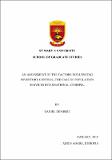| dc.description.abstract | The purpose of this study was to assess the factors influencing inventory control in
Population Services International Ethiopia. The various factor influencing inventory
control were broken into bureaucratic procurement procedure, carrying cost ,stock audit
practice ,stock record practice and staff skill & experience. The particular objective that
were analyzed include; evaluation of the effects of procurement procedure to the
effectiveness of inventory control, examination of the effect of high inventory carrying
cost to the effectiveness of inventory control, determination of the effects of stock audit
practices to the effectiveness of Inventory control, analysis of the effects of poor stock
record practice to effectiveness of inventory control, and examination of the effects of staff
skill & experience to the effectiveness of inventory control. The research adopted
descriptive study design. A stratified random sampling technique was applied to the study.
The researcher used a sample size of 30% of the target population to act as the sample
size. The researcher used questionnaire to collect data for the research. The questionnaire
contained open and closed ended questions and five point Likert scale questions and
covered areas of inventory control to come up with good raw data for the research. The
collected data were quantitatively analyzed using statistical methods such as SPSS which
was commanded to produce frequency tables, graphs and pie charts for effective
interpretation. The key findings from the study revealed that: delays in procurement of
goods, frequent stock-outs and no use of mathematical model were some of the effects of
long bureaucratic procurement procedure. According to the study, some products were
over stocked, expired, damage and obsolete that eventually increase carrying cost were
some of the effects in inventory control. The study revealed that lack of specific time or
date for stock taking exercise and discrepancies between actual and physical stock
balances were some of the effects of stock audit practice. The study also revealed that
unavailability of fully computerized system all over the organization, lack of specific time
or date for posting stock records, lack of adequately trained staff hinders effective
performance of the organization. The researcher recommends that cumbersome rules and
reliance on rigid rules and policies that slow down procurement process should be
avoided; current inventory control practices and procedures need to be reviewed and
redesigned. The management should stay up-to-date on inventory carrying cost. Only
qualified and adequately trained personnel should be involved in stock control. | en |


